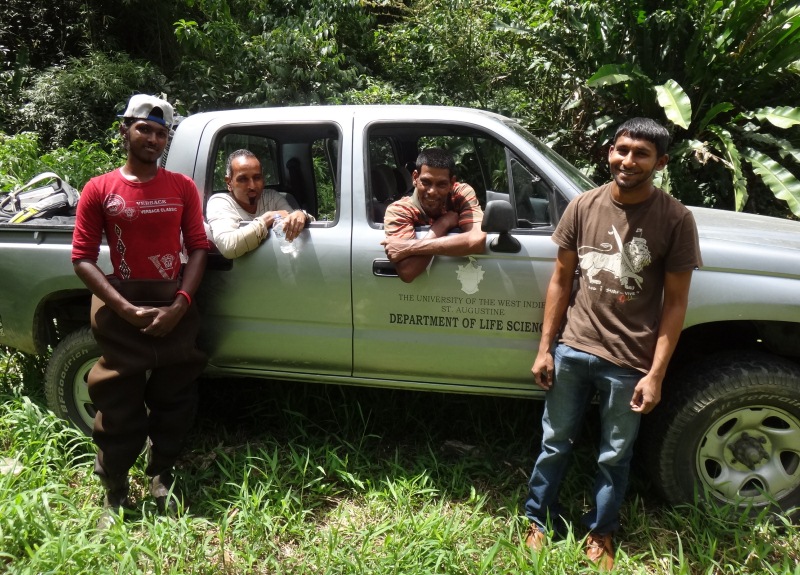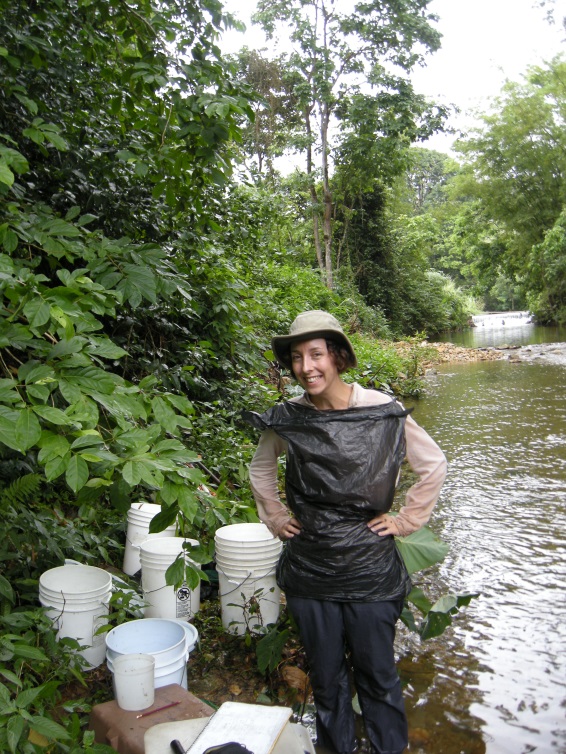BioTIME Blog
Introducing BioTIME Trinidad

The rainforest-covered mountains of a Caribbean island are the location of the BioTIME Trinidad project. Here, the numerous parallel streams of Trinidad’s Northern Range provide an ideal ‘natural laboratory’ for investigating patterns of biodiversity over time.
As a post-doc on the project, my job includes coordinating the data collection and managing an enthusiastic team of field and lab assistants – as well as many hours wading through some of the most (and least!) beautiful streams on the island.
We will soon be entering the final year of this exciting 5 year project. Through this blog, I hope to write about some of the adventures we have in the field and highlight any interesting discoveries we make along the way…
May 2014
Dry season sampling – complete!

Avinash Deonarinesingh, Raj Mahabir, Kharran Deonarinesingh, Devan Inderlall
An especially cheerful BioTIME Trinidad fieldwork team having just completed the final survey of the session, at the beautiful Acono river. This session has coincided with the dry season, and water levels have been noticeably lower. Seasonal differences such as this can also affect patterns of biodiversity over time, which is the focus of the BioTIME project. The next set of surveys will begin in August, by which time the rains will have returned.

Avinash Deonarinesingh, Raj Mahabir, Kharran Deonarinesingh, Amy Deacon
August 2014
Rain in the rainforest and pseudoscorpions in our samples…
Trinidad’s tropical climate consists of a dry season and a rainy season. Our August sampling session falls in the middle of the rainy season, which this year certainly lived up to its name. Miraculously, we managed to avoid postponing or abandoning any sampling sessions, despite getting completely drenched on several occasions.

It is times like this that I am thankful for my waterproof field notebook, but even more so for my dedicated field colleagues Raj, Kharran and Avinash, who manage to keep their sense of humour even when attempting to shelter under futile banana-leaf umbrellas with cold rain trickling down their backs. When you are soaked to the skin, even tropical Trinidad can feel cold…
Meanwhile, back on campus, BioTIME research assistant Devan has been making some exciting discoveries in the laboratory. While sorting through the benthic samples from the April-May session he came across our first pseudoscorpion! This tiny arachnid looks just like a scorpion but without the sting in the tail (although many have venom glands on their pedipalps instead), and is typically found in leaf-litter on the forest floor. There are 16 species recorded from Trinidad, but none are aquatic so this one most likely fell into one of our sample zones from the riverbank. We find a great diversity of creatures in these samples, from fierce-looking dragonfly larvae to limpet-like water pennies, and it is always exciting to find something new.

Our next sampling will take place in October, and will mark the start of the project’s final year. In the meantime Devan and I will be in the nice, dry lab, continuing to process the invertebrate and diatom samples that we have collected this summer. Who knows what we might find…